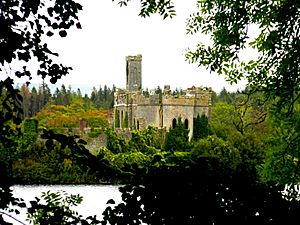McDermott's Castle facts for kids
Quick facts for kids McDermott's Castle |
|
|---|---|
| Native name Irish: Carraig Mhic Dhiarmada |
|
| The Rock MacDermot's Castle Carrick McDermott |
|
 |
|
| Type | Castle |
| Location | Castle Island, Lough Key, County Roscommon, Ireland |
| Owner | State |
| Official name: McDermott's Castle (Castle Island) | |
| Reference no. | 586 |
| Lua error in Module:Location_map at line 420: attempt to index field 'wikibase' (a nil value). | |
McDermott's Castle is an amazing old castle and a special National Monument in County Roscommon, Ireland. It has a long and exciting history! This castle sits on a small island in a beautiful lake.
Contents
Where is McDermott's Castle?
McDermott's Castle is found on Castle Island. This tiny island is about half an acre in size. You can find it in the southeast part of Lough Key.
The Castle's Long History
The Mac Diarmada family were powerful rulers. They controlled an area called Magh Luirg from the 900s to the 1500s. A castle has stood on this island for a very long time.
A Fiery Event in 1184
In 1184, something dramatic happened. The Annals of Loch Cé (which are like old history books) tell us about a big fire. A lightning bolt struck the castle. It was a huge, royal home for the Mac Diarmada family. Sadly, many people and valuable things were lost in the fire.
About 120 to 140 important people died. This included 15 kings and chiefs. The wife of Mac Diarmada and his son's wife also passed away. Many others were lost too. Anyone who wasn't burned was drowned trying to escape. Only Conchobar mac Diarmata and a few others survived.
Conquest and Siege in 1235
The castle was rebuilt after the fire. In 1235, it played a part in the conquest of Connacht. This was when Richard Mór de Burgh, 1st Baron of Connaught took control of the area. The castle was attacked. First, a catapult on a raft was used. Then, attackers used fire ships to burn it. Cormac MacDermott, who was the King of Moylurg, had to give up the castle.
The Legend of the Hag of Lough Key
There's a famous poem about Tomaltach an Einigh mac Diarmata. He was King of Moylurg from 1421 to 1458. The poem tells the story of the Hag of Lough Key. She stayed at the castle for a whole year. She used the kindness of Cormac MacDermott (who was king from 1218 to 1244). Because of her, the McDermotts were always expected to be very welcoming to guests.
Losing the Island and Later Years
The McDermott family lost control of the island in 1586. A poet named Eochaidh Ó hÉoghusa wrote a sad poem about the empty castle.
In 2014, the castle appeared on the TV show Moone Boy. It was shown as the home of a mysterious character called "Island Joe."
In 2018, the castle was put up for sale. But the offer was later taken back. The castle is now owned by the Irish government again.
Discoveries from Digs
In 2019, archaeologists dug up parts of the island. They found that the island has been a fortified place for a very long time. The oldest parts date back to early medieval times. They found an older, thick wall that was two to three meters wide. This wall was built before the one we see today.
They also found medieval buildings from the 1200s. These were on the north side of the island. Cool, fancy items were discovered. These included silver pins and a gaming piece. They also found many bones from cattle, boar, and sheep. This research was even featured in Archaeology Magazine!
What the Castle Looks Like Today
The castle you see today has parts from different times. The wall around the island is very old. Experts think it might be from the medieval period.
Inside the main building, there's a late medieval tower house. You can still see an arrow slot and medieval windows on its western wall. The parts added to the sides of the tower were built much later. These were added by an architect named John Nash in the early 1800s. He also put new windows into the old tower house.
The castle was used as a summer house for a while. Sadly, it burned down during the Second World War.


